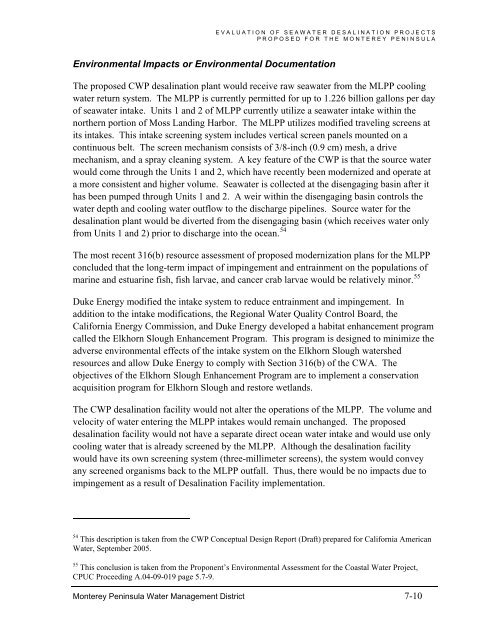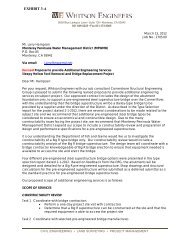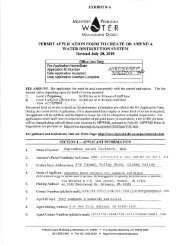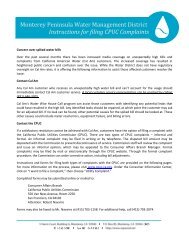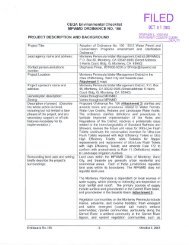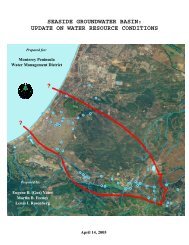FINAL REPORT Evaluation of Seawater Desalination Projects ...
FINAL REPORT Evaluation of Seawater Desalination Projects ...
FINAL REPORT Evaluation of Seawater Desalination Projects ...
Create successful ePaper yourself
Turn your PDF publications into a flip-book with our unique Google optimized e-Paper software.
EVALUATION OF SEAWATER DESALINATION PROJECTS<br />
PROPOSED FOR THE MONTEREY PENINSULA<br />
Environmental Impacts or Environmental Documentation<br />
The proposed CWP desalination plant would receive raw seawater from the MLPP cooling<br />
water return system. The MLPP is currently permitted for up to 1.226 billion gallons per day<br />
<strong>of</strong> seawater intake. Units 1 and 2 <strong>of</strong> MLPP currently utilize a seawater intake within the<br />
northern portion <strong>of</strong> Moss Landing Harbor. The MLPP utilizes modified traveling screens at<br />
its intakes. This intake screening system includes vertical screen panels mounted on a<br />
continuous belt. The screen mechanism consists <strong>of</strong> 3/8-inch (0.9 cm) mesh, a drive<br />
mechanism, and a spray cleaning system. A key feature <strong>of</strong> the CWP is that the source water<br />
would come through the Units 1 and 2, which have recently been modernized and operate at<br />
a more consistent and higher volume. <strong>Seawater</strong> is collected at the disengaging basin after it<br />
has been pumped through Units 1 and 2. A weir within the disengaging basin controls the<br />
water depth and cooling water outflow to the discharge pipelines. Source water for the<br />
desalination plant would be diverted from the disengaging basin (which receives water only<br />
from Units 1 and 2) prior to discharge into the ocean. 54<br />
The most recent 316(b) resource assessment <strong>of</strong> proposed modernization plans for the MLPP<br />
concluded that the long-term impact <strong>of</strong> impingement and entrainment on the populations <strong>of</strong><br />
marine and estuarine fish, fish larvae, and cancer crab larvae would be relatively minor. 55<br />
Duke Energy modified the intake system to reduce entrainment and impingement. In<br />
addition to the intake modifications, the Regional Water Quality Control Board, the<br />
California Energy Commission, and Duke Energy developed a habitat enhancement program<br />
called the Elkhorn Slough Enhancement Program. This program is designed to minimize the<br />
adverse environmental effects <strong>of</strong> the intake system on the Elkhorn Slough watershed<br />
resources and allow Duke Energy to comply with Section 316(b) <strong>of</strong> the CWA. The<br />
objectives <strong>of</strong> the Elkhorn Slough Enhancement Program are to implement a conservation<br />
acquisition program for Elkhorn Slough and restore wetlands.<br />
The CWP desalination facility would not alter the operations <strong>of</strong> the MLPP. The volume and<br />
velocity <strong>of</strong> water entering the MLPP intakes would remain unchanged. The proposed<br />
desalination facility would not have a separate direct ocean water intake and would use only<br />
cooling water that is already screened by the MLPP. Although the desalination facility<br />
would have its own screening system (three-millimeter screens), the system would convey<br />
any screened organisms back to the MLPP outfall. Thus, there would be no impacts due to<br />
impingement as a result <strong>of</strong> <strong>Desalination</strong> Facility implementation.<br />
54 This description is taken from the CWP Conceptual Design Report (Draft) prepared for California American<br />
Water, September 2005.<br />
55 This conclusion is taken from the Proponent’s Environmental Assessment for the Coastal Water Project,<br />
CPUC Proceeding A.04-09-019 page 5.7-9.<br />
Monterey Peninsula Water Management District 7-10


